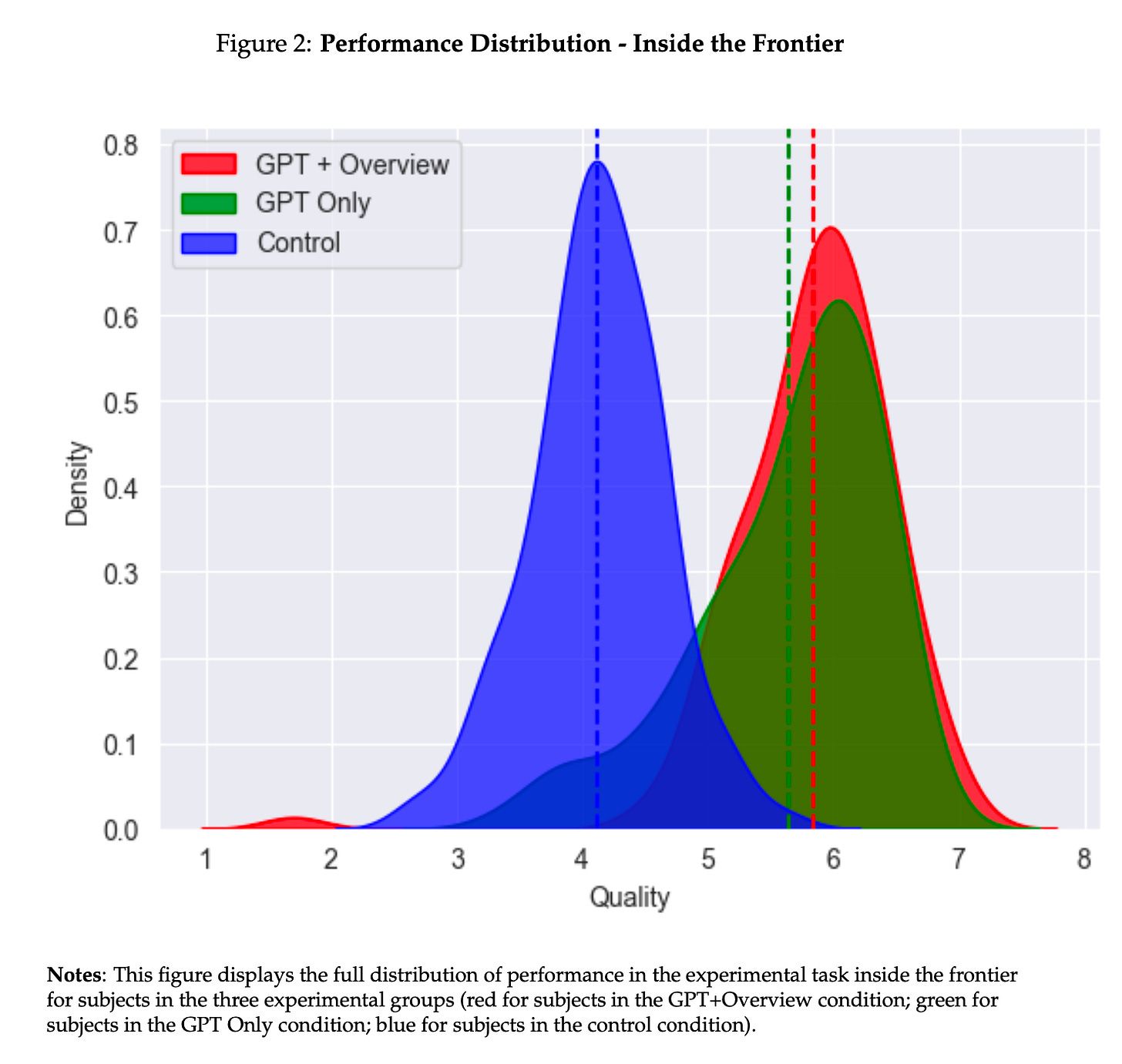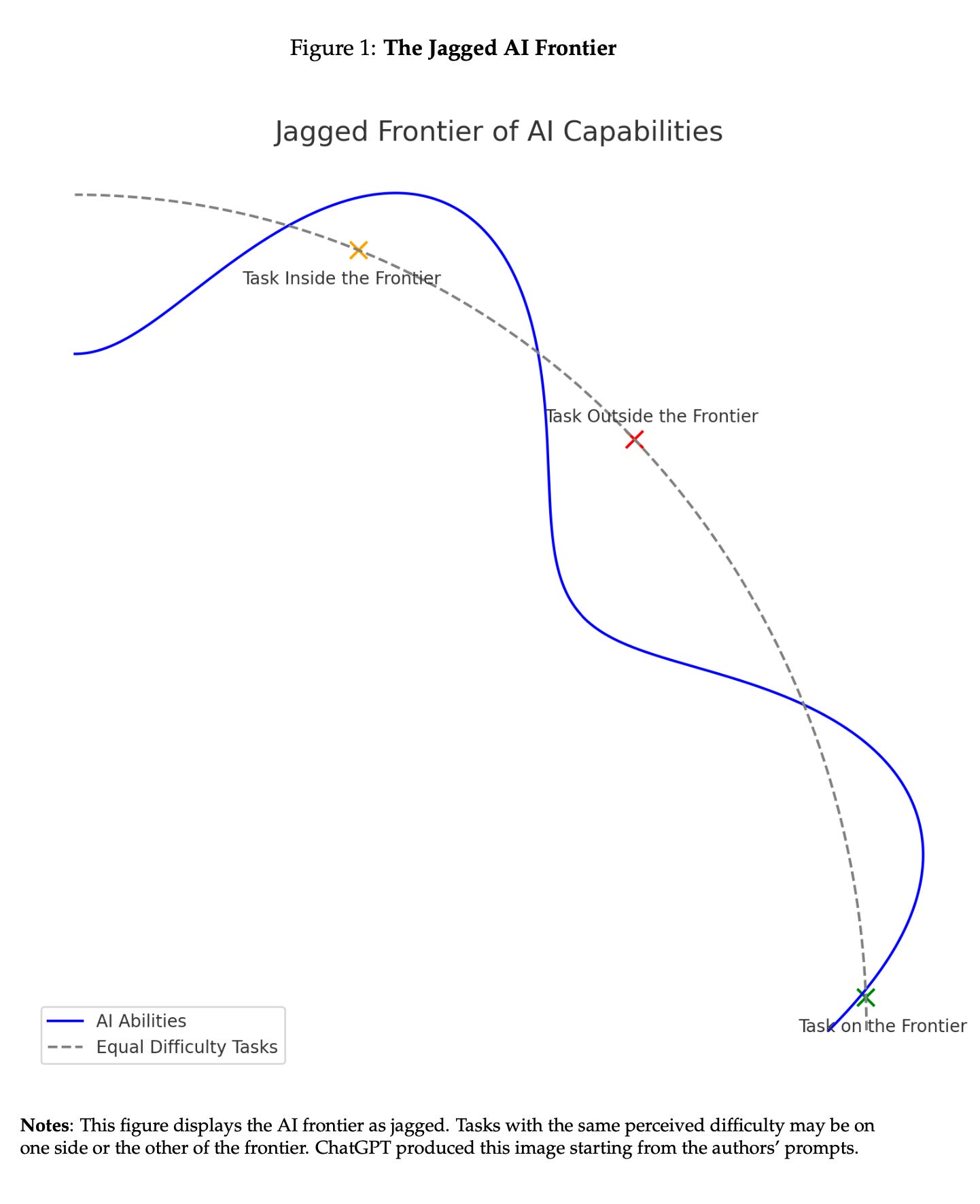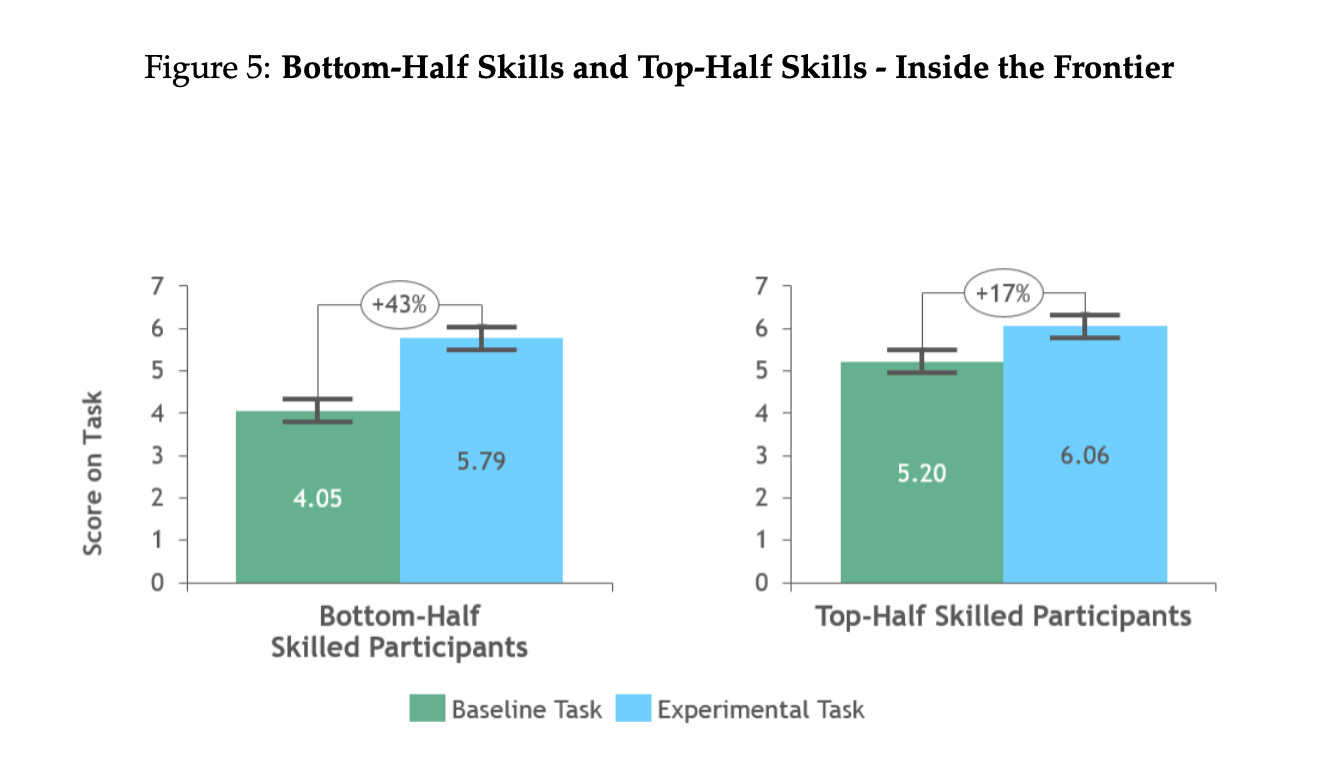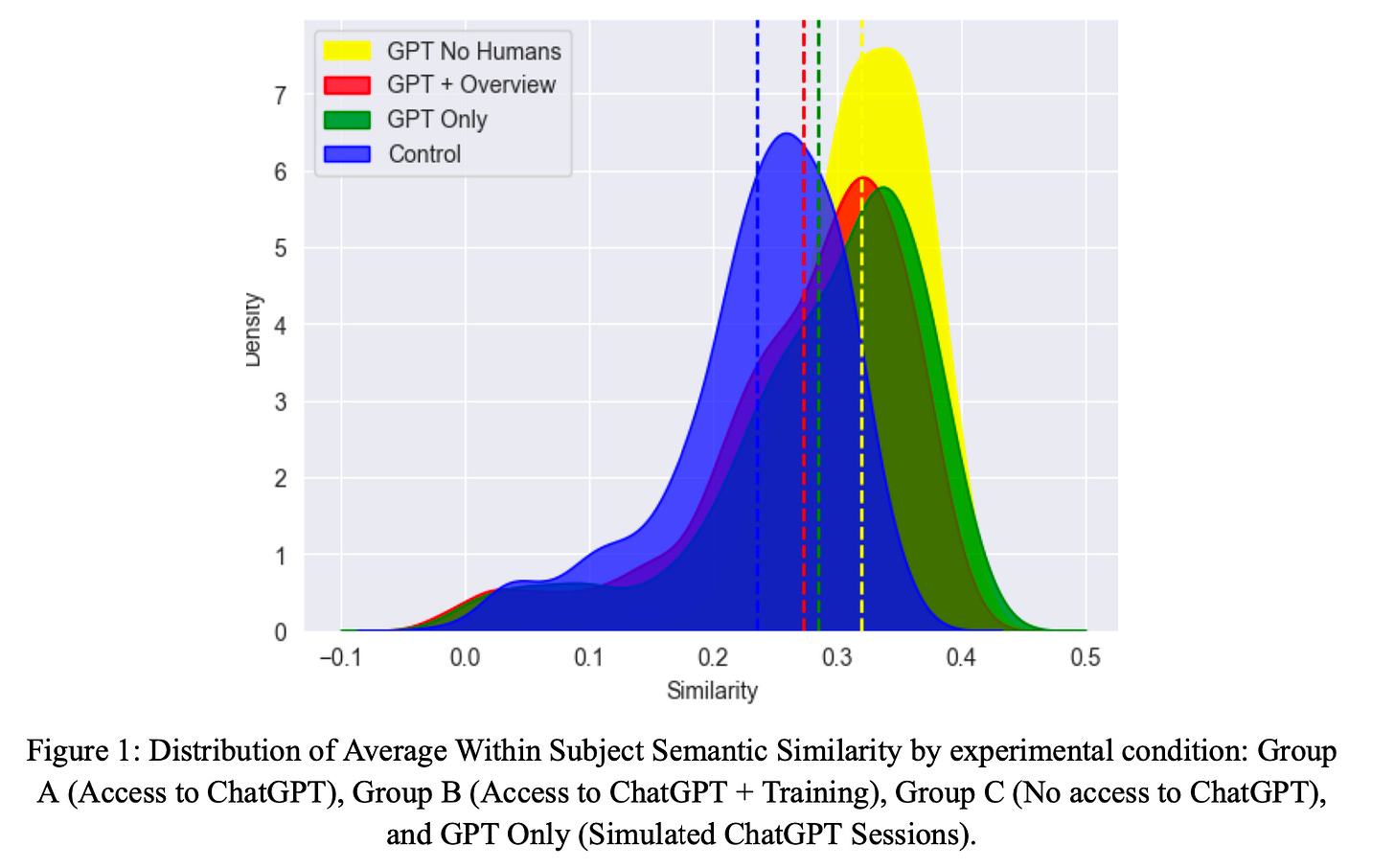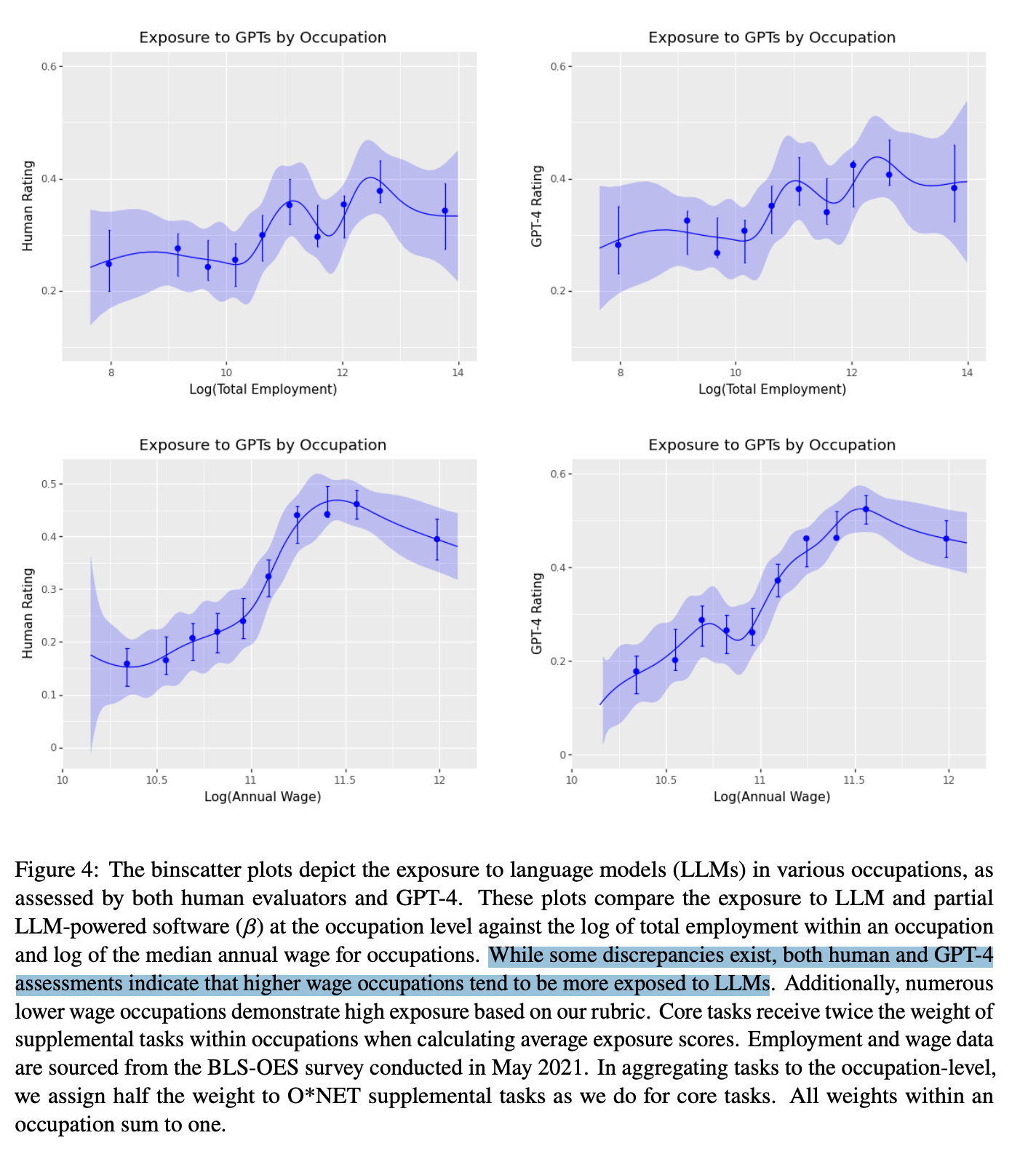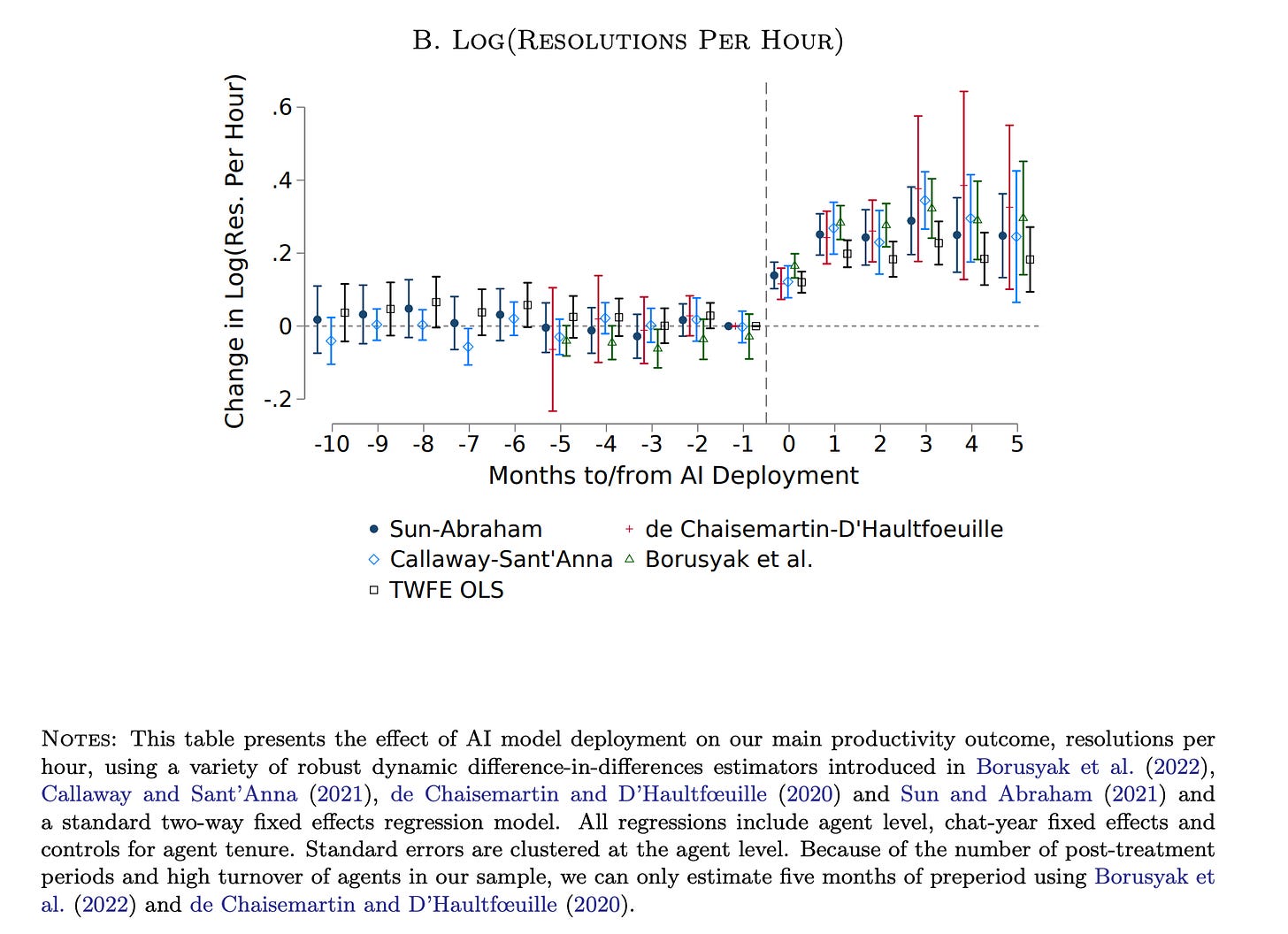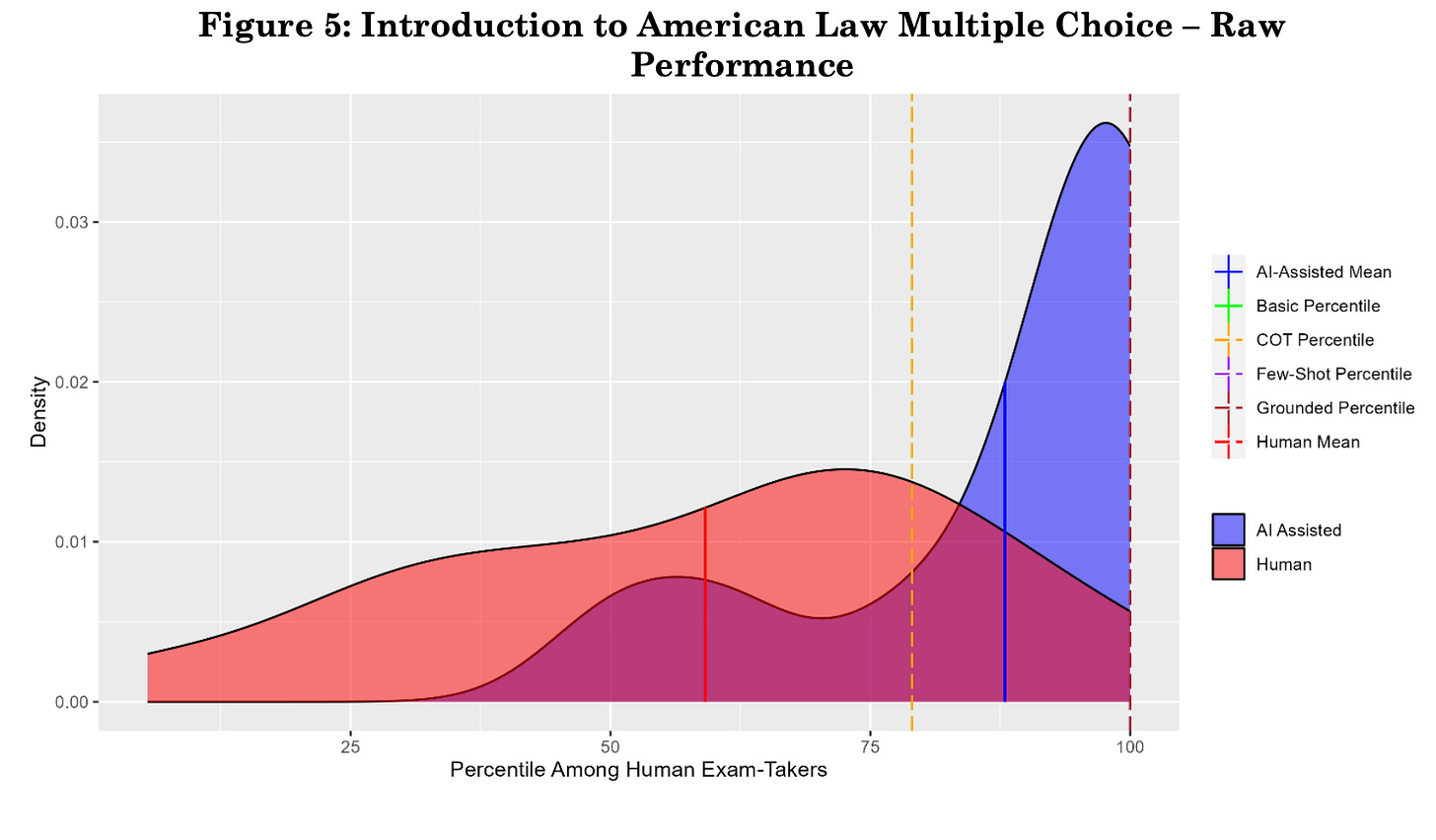Artificial Intelligence as The Great Equalizer
AI is transforming work, acting as a great equalizer. It boosts productivity for novices, challenges experts, and redefines skill value. Explore how this shift impacts various industries and job roles
Hello, fellow tech visionaries! Welcome back to the front lines of the AI, where the rules of work are being rewritten in real-time. In this episode of Tech Trendsetters, we're into concrete examples and groundbreaking studies that reveal the true impact of AI on human productivity and the division of labor.
Where AI doesn't just replace tasks – it transforms how we think about skill, productivity, and the very nature of work itself.
From high-stakes business executives to customer service, from courtrooms to classrooms, we'll explore how AI is bridging gaps, boosting your productivity, and sometimes stumping the experts. Get ready to discover:
Why your barista might be safer from AI than your Wall Street analyst;
How AI is compressing years of experience into months and will act as a great equalizer among people;
Why the future of work might depend more on your AI collaboration skills than your Ivy League degree;
By the end of this episode, you’ll see how AI is becoming the great equalizer and learn how to take advantage of it!
Quantifying the Impact of AI
The world of work is changing, and at the heart of this transformation lies the rise of Artificial Intelligence. No longer a futuristic fantasy, AI is becoming an integral part of our everyday lives. If it’s not already part of yours, consider this your sign from above – it’s time to pay attention.
Meanwhile, as AI tools become increasingly sophisticated and available, their impact on business operations and knowledge work is becoming measurable and significant.
I recently found an interesting study “Navigating the Jagged Technological Frontier” conducted by researchers from Harvard Business School and the Wharton School, in collaboration with the Boston Consulting Group (BCG), that offers concrete data on how AI is reshaping the landscape of high-level consulting work. This extensive field experiment involved over 750 professional consultants, providing another angle into the real-world effects of AI integration in a knowledge-intensive industry.
The study focused on the use of large language models, specifically GPT-4, in day-to-day consulting tasks. By comparing the performance of consultants with and without access to AI tools, the researchers were able to quantify the impact of AI on productivity, speed, and quality of work.
Key findings include:
Consultants using AI completed 12.2% more tasks on average, which can be evidence of at least some productivity increase.
Tasks were completed 25.1% faster with AI assistance, which in my opinion is a great speed improvement. Where the workers will spend this spare time is part of another question.
Most importantly – quality improvements: the quality of work saw a significant boost, improving by more than 40% compared to the control group.
Understanding AI's Uneven Capabilities
While these headline figures are impressive, the study reveals a more nuanced picture of AI's impact on knowledge work. The researchers introduce a critical concept: the "jagged technological frontier." This idea challenges our assumptions about AI's capabilities and limitations.
To better explain what the jagged frontier is, consider a landscape of business challenges. Some tasks, despite seeming complex, are easily solved by AI. Others, apparently similar, remain beyond AI's grasp. This uneven distribution of AI capabilities creates a jagged frontier – a boundary that's neither smooth nor predictable. Understanding this frontier is crucial for effectively integrating AI into workflows, as it challenges us to critically assess where AI truly adds value and where human expertise remains essential.
Case in point: when faced with tasks specifically designed to fall outside AI's current capabilities, consultants relying on AI stumbled. They were 19 percentage points less likely to produce correct solutions compared to their AI-free counterparts.
But, even when AI led consultants to incorrect conclusions, it still managed to elevate the overall quality of their work. The recommendations and analyses produced with AI assistance were rated higher in quality, regardless of their accuracy. This paradox underscores the complex nature of AI's impact on professional output.
AI's Uneven Impact Across Skill Levels
Another intriguing finding concerns AI's effect on workers across different skill levels. While everyone benefited from AI augmentation, the gains were not distributed equally:
Consultants in the bottom half of the performance distribution saw their output improve by a whopping 43%;
Top performers, already operating at a high level, still managed to boost their performance by 17%.
This disparity suggests that AI might serve as a “great equalizer” in the workplace, potentially narrowing the gap between top performers and those still developing their skills. However, it also raises questions about the future of skill development and career progression in an AI-augmented world.
Centaurs and Cyborgs
As professionals grapple with this new AI-enhanced reality, two distinct work patterns are emerging:
The Centaur Approach
Like the mythical half-human, half-horse creatures, these workers seamlessly switch between AI and human tasks. They have a keen sense of when to leverage AI's strengths and when to rely on their own expertise.The Cyborg Method
These users take integration to the next level, blending their efforts with AI at an almost atomic level. They don't just delegate tasks – they work in tandem with the AI, constantly refining and iterating.
Both strategies require a deep understanding of AI's capabilities and limitations, as well as a willingness to adapt and experiment. The most successful professionals aren't just using AI as a tool – they're fundamentally changing how they approach problem-solving.
Original Human Ideas vs AI-Enhanced Creativity
One final observation from the study gives us pause for thought. While AI demonstrably improved the quality of ideas generated by consultants, it also led to more homogenized outputs. In other words, the ideas produced with AI assistance were better on average, but also more similar across different users.
This trend towards homogeneity raises important questions about the role of diversity and unique perspectives in problem-solving and innovation. As we rush to embrace AI's undeniable benefits, we must also consider how to preserve the value of truly original, human-generated ideas.
AI as Great Equalizer
Yeah, AI being a Great Equalizer is how I see the future of our world. So I believe the concept of "great equalizer" deserves a closer examination. This phrase encapsulates a powerful and potentially transformative aspect of Artificial Intelligence, particularly LLMs, in the context of work and productivity. While much of the discourse surrounding AI has focused on its potential to automate jobs and replace people with soulless machines, much research reveals a more nuanced and potentially optimistic narrative.
I'm diving into this topic because I believe the equalizing power of AI is going to reshape our workforce in ways we're only beginning to understand. It's not just about robots taking jobs – it's about AI leveling the playing field. To back up my perspective, I've been digging into some more fascinating studies.
One another study I found particularly relevant was conducted by researchers from OpenAI, OpenResearch, and the University of Pennsylvania. Their working paper, titled "GPTs are GPTs: An Early Look at the Labor Market Impact Potential of Large Language Models," offers some insights into how LLMs might affect various occupations across the U.S. economy.
Widespread Impact
Bottom line; it’s just another study that confirms that the impact of LLMs on the job market is set to be far-reaching. Significant portion of our daily work could soon be performed with minimal or less human involvement, yet maintaining the same standards we see today:
80% of all professions and jobs in the US will be affected by LLMs;
At least 10% of tasks in these jobs will be automated without loss of quality;
For 19% of all employees, over 50% of their daily tasks could be automated.
The Surprising Nature of the Great Equalizer
What's particularly intriguing about this research is how it challenges our assumptions about which jobs are most susceptible to AI influence. Contrary to popular belief, it's not the lower-paying jobs that are most exposed to this wave of automation. The study reveals a clear trend: the higher the level of education and salary, the more automation is likely to appear in the profession.
This creates a stark contrast across the job market:
Low automation impact: Baristas, plumbers, hairdressers;
High automation impact: Wall Street analysts, legal consultants, software developers.
To put this into perspective, for professions with an average salary of $30,000 per year, only about 5% of tasks are subject to automation. However, for jobs with an average salary of $80,000, this jumps to a whopping 50%. This disparity suggests that AI and LLMs could indeed act as a great equalizer in the job market, potentially narrowing the gap between high and low-paying jobs.
The Broader Economic Impact
When we zoom out research results to look at the economy as a whole, the potential impact is substantial and highlights the same numbers we've likely heard before:
Current LLM technology could automate ~15% of all tasks in the economy without quality loss;
Considering potential LLM-based products, this could rise to 47% of tasks.
It's important to note that this doesn't necessarily mean job losses, but rather a significant change in the nature of many jobs.
The New General-Purpose Technology
The researchers conclude that LLMs are a general-purpose technology, similar to electricity. This classification assumes that:
Most use cases haven't emerged yet or are in very early stages;
The technology will continue to improve over time;
The impact percentages are likely to increase as the technology matures.
This, again, suggests that we've only scratched the surface of what's possible with LLMs. As the technology evolves, its impact on the job market and the broader economy is likely to grow even further. By the way, that perspective closely aligns with Goldman Sachs' views on AI, which we reviewed in one of our previous episodes:
The Future of Work and Skill Equalization
Now let’s explore more examples and studies on the impact of AI on human productivity and division of labor. Spoiler alert: they all confirm the aforementioned thesis of the great equalizer.
AI Across Industries and The Broader Workplace Impact
First, let's examine the study "Generative AI at Work" by Erik Brynjolfsson and colleagues that looks at AI's impact across different types of jobs. Their research focused on the deployment of a chat assistant at a Fortune 500 software firm that provides business process software. The study analyzed data from 5,179 customer support agents over several months as the AI tool was gradually rolled out.
The AI system used was built on a recent version of GPT, combined with additional machine learning algorithms specifically fine-tuned for customer service interactions. It was trained on a large set of customer-agent conversations, labeled with various outcomes and characteristics. The system generated real-time suggestions for how agents should respond to customers and provided links to relevant technical documentation.
The main findings that reinforce this great equalizer effect:
Access to the AI tool increased overall productivity, as measured by issues resolved per hour, by 14% on average;
Novice and low-skilled workers saw a dramatic 35% improvement in productivity, while experienced and highly skilled workers saw minimal impact;
AI-assisted agents with two months of tenure performed just as well as untreated agents with more than six months of tenure;
The study found that AI assistance improved customer sentiment and increased employee retention;
There was evidence of worker learning, with productivity gains persisting even during AI system outages.
Interestingly, the study also found that the benefits of AI assistance increased over time. Agents who initially adhered less to AI suggestions gradually increased their usage, suggesting a learning curve in effectively utilizing AI assistance.
This study aligns closely with all of our earlier observations and quantifies the significant boost that AI can provide. Especially for those less experienced workers, effectively compressing the traditional experience curve.
AI in Legal Analysis
Building on these insights, let's turn to a more specific study “AI assistance in legal analysis: An empirical study” by Jonathan Choi and Daniel Schwarcz, both Professors of Law, which examines AI's role in legal analysis – specifically, how GPT-4 influences law students' exam performance. This study took an innovative approach by allowing students to use GPT-4 while tackling law school exams.
The results are quite interesting and align closely with our earlier findings:
For multiple-choice questions, AI assistance produced a 29 percentile-point performance improvement relative to these students' performance on the real exam.
For essay questions requiring deeper legal reasoning, GPT-4 didn't significantly improve grades. This limited impact on complex tasks aligns with the observation that AI excels at routine tasks but struggles with higher-order thinking.
The equalizing effect. The worst-performing students benefited enormously from AI, with gains of approximately 45 percentile points. In contrast, the best-performing students received worse grades when given access to AI, experiencing declines of approximately 20 percentile points.
In the Introduction to American Law class, students completed exams in an average of 62.9 minutes with AI assistance, compared to 74.5 minutes without, which represent a moderate speed improvement.
The study also evaluated GPT-4 standalone performance using different prompting techniques. In a basic law class, GPT-4 alone achieved grades ranging from B+ to A, while in an advanced class, it scored between B and A-. These grades were relative to a B+ median for human students, indicating that GPT-4 performed at or above average in both settings.
The researchers found that "grounded" prompting, where GPT-4 was provided with relevant source materials (like lecture notes), resulted in the best performance. With this technique, GPT-4 outperformed both human students alone and human students with access to GPT-4. This suggests that the effectiveness of AI in legal analysis can be significantly enhanced by providing it with appropriate context and information. Curious how to do that? Refer to one of my previous episodes on Retrieval-Augmented Generation (RAG) techniques:
I think all these findings only reinforce our understanding of AI as a powerful equalizing force. It's particularly effective at boosting performance on structured tasks and helping less skilled individuals bridge the gap with their higher-performing peers. However, it also raises questions about the potential negative impact on top performers and the limitations of AI in complex reasoning tasks.
AI as the Great Equalizer in Real-World
As we move into the next chapter, let's shift our focus to how AI is making a real difference in people's everyday lives. We've talked about AI's potential to boost productivity and bridge skill gaps, but what does that actually look like in the real world? How is it changing things for people like you and me?
Well, AI is proving to be a powerful equalizer across various fields. While we’re still in the early stages, there are multiple examples of enabling people to accomplish tasks they previously couldn't even approach:
James Brooks, a social media marketer, created an app using AI and no-code tools without any prior programming experience. He developed "Thingy Bridge," a platform connecting brands with influencers for promotional collaborations.
Anyone can now generate high-quality graphics, including images or short videos for blog posts, books, or presentations, rivaling top illustrators. For instance, generative AI can be used to design user interfaces that are intuitive and user-friendly, a task that previously required specialized design skills.
AI provides contract analysis comparable to average lawyers, but for free instead of $200. It can even draft legal documents; for example, some AI-startups can generate a legal complaint letter for issues like poor service or faulty products, formatted according to the latest legal standards.
Students receive personalized, engaging explanations of complex topics and custom-generated study programs that rival those of top educators. The implications for self-education are huge – high-quality, personalized learning is now more accessible than ever before, all of that on a global scale.
AI rivals many creative fields. For instance, musicians can now use specialized AI tools to compose original scores or generate backing tracks, allowing even those without formal music training to create professional-sounding music.
Daily examples abound: summarizing calls, editing texts, analyzing documents, studying machine learning, and writing/analyzing code in unfamiliar languages. Capabilities that were once limited to experts in those fields now unlocked for everyone.
This is just the beginning. While AI products formally have nearly a billion users across all platforms, the number of real power users who have experienced this equalizing force is estimated to be only in the tens of thousands.
TLDR;
The great equalizer in the context of AI refers to its ability to significantly boost the productivity and capabilities of less skilled or experienced workers, while having a more modest or even potentially negative impact on top performers. This effect narrows the performance gap between workers at different skill levels.
"So the last will be first, and the first last" – Matthew 20:16.
This biblical verse resonates surprisingly well with the impact of AI in the workplace, as we've learned today:
AI consistently demonstrates a significant increase in productivity across various fields, with studies showing improvements ranging from 12% to 25% in task completion and speed.
The quality of work improves substantially with AI assistance, as evidenced by a 40% increase in consulting work quality and improved customer sentiment in support interactions.
AI shows a strong equalizing effect by narrowing the skill gap, benefiting less experienced workers more than top performers and allowing newer employees to perform at levels comparable to their more experienced colleagues.
Current large language model technology has the potential to automate about 15% of all tasks in the economy without loss of quality, with projections suggesting this could rise to 47% with future advancements.
The impact of AI automation is unevenly distributed across job types, with higher-paying, education-intensive jobs more likely to be affected than lower-paying, manual labor jobs.
Workers demonstrate improved ability to use AI tools over time, suggesting a learning curve in AI collaboration and indicating that productivity gains can persist even during AI system outages.
New work patterns are emerging, such as the "Centaur Approach" where workers seamlessly switch between AI and human tasks, and the "Cyborg Method" involving deep integration of AI in the workflow.
AI shows limitations in tasks requiring deep, complex reasoning, as demonstrated by its limited impact on essay questions in legal exams.
While AI improves overall quality, it also leads to more homogenized outputs, raising concerns about preserving diverse perspectives in problem-solving and innovation.
All findings suggest that future workplace success may depend more on AI collaboration skills than traditional credentials or experience, rethinking how we value and develop professional skills.
These findings align perfectly with my longstanding observation about the nature of work in many businesses – I have always been amazed by the amount of pointless, stupid and unnecessary work in many businesses, especially large ones. In some roles, it was close to 100%. Now, this problem has been solved: pointless work is done by robots, and people, even unskilled ones, perform relatively "difficult" work with the help of machines.
However, this shift also presents challenges. The goal isn't simply to replace humans with AI, but to create a symbiotic relationship where AI handles the "stupid work," freeing humans to focus on higher-order thinking and complex and creative problem-solving. And we need to rethink job design, skill development, and how we value human expertise in such AI-augmented world.
Today we are using the most stupid, useless and primitive version of generative AI in our entire lives. Current AI technology, despite its transformative effects, is just the beginning.
Success won't just be about what you know or what you can do. It will be about how well you can collaborate with AI to amplify your abilities and those of others. It's about using AI not just to be more productive, but to be more human. Signing off and hope this was an interesting reading,for you! Until next time!
🔎 Explore more:



